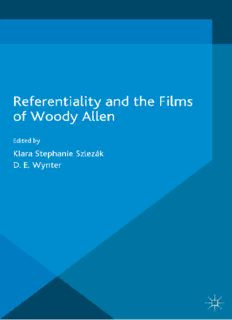
Referentiality and the Films of Woody Allen PDF
Preview Referentiality and the Films of Woody Allen
Referentiality and the Films of Woody Allen This page intentionally left blank Referentiality and the Films of Woody Allen Editedby Klara Stephanie Szlezák PassauUniversity,Germany D. E. Wynter CaliforniaStateUniversity,Northridge,USA Selection,introductionandeditorialmatter©KlaraStephanieSzlezák andD.E.Wynter2015 Individualchapters©Respectiveauthors2015 Foreword©DavidDesser2015 Softcover reprint of the hardcover 1st edition 2015 978-1-137-51546-9 Allrightsreserved.Noreproduction,copyortransmissionofthis publicationmaybemadewithoutwrittenpermission. Noportionofthispublicationmaybereproduced,copiedortransmitted savewithwrittenpermissionorinaccordancewiththeprovisionsofthe Copyright,DesignsandPatentsAct1988,orunderthetermsofanylicence permittinglimitedcopyingissuedbytheCopyrightLicensingAgency, SaffronHouse,6–10KirbyStreet,LondonEC1N8TS. Anypersonwhodoesanyunauthorizedactinrelationtothispublication maybeliabletocriminalprosecutionandcivilclaimsfordamages. Theauthorshaveassertedtheirrightstobeidentifiedastheauthorsofthiswork inaccordancewiththeCopyright,DesignsandPatentsAct1988. Firstpublished2015by PALGRAVEMACMILLAN PalgraveMacmillanintheUKisanimprintofMacmillanPublishersLimited, registeredinEngland,companynumber785998,ofHoundmills,Basingstoke, HampshireRG216XS. PalgraveMacmillanintheUSisadivisionofStMartin’sPressLLC, 175FifthAvenue,NewYork,NY10010. PalgraveMacmillanistheglobalacademicimprintoftheabovecompanies andhascompaniesandrepresentativesthroughouttheworld. Palgrave®andMacmillan®areregisteredtrademarksintheUnitedStates, theUnitedKingdom,Europeandothercountries. ISBN 978-1-349-57081-2 ISBN 978-1-137-51547-6 (eBook) DOI 10.1057/9781137515476 Thisbookisprintedonpapersuitableforrecyclingandmadefromfully managedandsustainedforestsources.Logging,pulpingandmanufacturing processesareexpectedtoconformtotheenvironmentalregulationsofthe countryoforigin. AcataloguerecordforthisbookisavailablefromtheBritishLibrary. LibraryofCongressCataloging-in-PublicationData ReferentialityandthefilmsofWoodyAllen/[editedby]KlaraStephanie Szlezák,UniversityofPassau,Germany;D.E.Wynter, CaliforniaStateUniversityNorthridge,USA. pages. cm Summary:“ReferentialityandtheFilmsofWoodyAllenisascholarlycollection thatprovidesexpansiveexplorationoftheauteur’suseofintertexuality, referentiality,andfusionofmediaforms.ItsscopeisframedbyAllen’s intermedialphasebeginningin1983withZeligandhismostrecentfilm. Whilemanychaptersinthevolumedealwithtexts,severaldelveintoAllen’s processofreferentiality,hisaccessingnon-textualworks,materialobjects, andabstractconceptsintheformationofhiscinematicworks.Theseobjects andconceptsincludeavastarrayofphenomena,suchassexualorientation, historicalevents,timeandspace,geographiclocation,architecture,religion, philosophy,visualimages,music,magicandotherperformanceart. Characterizedbyinternational,interdisciplinaryperspectives,thiscollection elucidatespointsofdeparturewithinaswellasoutsideofAllen’sownoeuvre totracebothartisticlineagesandidiosyncratic! creationsinAllen’soverallfilmicwork.”—Providedbypublisher. 1. Allen,Woody—Criticismandinterpretation. I. Szlezák,Klara Stephanie,1980–editor. II. Wynter,D.E.,1959–editor. PN1998.3.A45R442015 791.4302(cid:2)3392—dc23 2015021816 Contents ForewordbyDavidDesser vii NotesonContributors x Introduction 1 KlaraStephanieSzlezákandD.E.Wynter Part I IntermedialityandForm 1 Zelig:ASimulatedLife 13 BrittaFeyerabend 2 WoodyAllen’sBlueJasmine:ASeductivelyScentedFlower PerforminginaTheatricalBubble 31 NassimWinnieBalestrini Part II EuropeanArt-CinemaandtheAuteur 3 “ThankGodtheFrenchexist”:ExploringtheReferentiality oftheFormalElementsofFilminDeconstructingHarry 51 MartinR.Hall 4 TwoandaHalf:Nostalgia,ModernParody,andFelliniin StardustMemories,RadioDays,andToRomewithLove 68 GiacomoBoitani Part III GreekMythologyRevisited 5 OedipusortheWrecksoftheWASPDisguise 87 NaamaHarel 6 WoodyAllenandtheAbsurdityofHumanExistence: Origin,Legacy,andHumanAgencyinGodandMighty Aphrodite 100 MichaelFuchs v vi Contents Part IV LiteraryMastersofNineteenth-Century Realism 7 “Afullmealwithavitaminpillandextrawheatgerm”: WoodyAllen,Dostoevsky,andExistentialMorality 119 ZacharyT.Ingle 8 “Darling,haveyouseenmyStrindbergbook?”:Dialogism asSocialDiscourseinMatchPoint 137 D.E.Wynter Part V ReferentialityandTransculturalImmersion 9 GuitarandCulturalTrespassinVickyCristinaBarcelona 159 AllanHavis 10 “HiMr.Hemingway”:TimeandSpace,Travel,andLiterary HeritageinMidnightinParis 173 KlaraStephanieSzlezák Part VI Identity:Conceptualizationand Performance 11 Woodyand“Woody”:TheMakingofaPersona 193 WielandSchwanebeck 12 MagicalTricksandIngmarBergman:Referentialityin MagicintheMoonlight 210 MariaElenadelasCarreras-Kuntz Index 227 Foreword Itishighlylikelythatfew,ifany,audiencesoutsideofJapanwouldknow Kokusai himitsu keisatsu: Kayaku no taru (1964) were it not for Woody Allen’sWhat’sUp,TigerLily?(1966).Amodesthit,especiallyamidstthe doldrums of mid-60s American cinema, the film convinced the former gagwriterandsuccessfulstand-upcomediantocontinuetoworkincin- ema.YetonehardlyknowswhattocallAllen’seffortintakingaJapanese spythrillerandevacuatingitsdialoguetrackinfavorofanabsurdplot and jokey repartee. Right at the start of his career Allen takes concepts of referentiality, intermediality, intertextuality, and collaboration to a placetheseterms,somenotyetinscholarlydiscourse,werenevermeant to go. Did Allen have Bakhtin in mind with his quite literal “dialogic imagination”vis-a-vistheJapaneseoriginal?Whilepostmoderntheory has it that every text is an intertext and the French nouvelle vague produced countless examples of great cinema out of pastiche, parody, homage,referentiality,andreflexivity,Allen’sprojectoverthecourseof somesixdecadesandalmost50filmshasbeensomethingdifferent:to createanoeuvreatoncecinematicallysophisticatedandphilosophically rigorous while retaining some basis in mainstream popularity. Numer- ous Academy Award wins and nominations, a number of box office hits, and a shelf-full of both academic and popular writings attest to theperhapsunprecedentedsuccessofhisefforts. Ofcourse,itdidn’tseemsoatthestart.Fewtook1969’sTaketheMoney andRunasanythingotherthanacomicuseofdocumentaryformtotell thestoryofalovableloser.Thedeformationofthedocumentarymodeis centraltothecomedyofthefilmasmuchaspoorVirgil’shopelessness at any kind of criminal competence. And so in combining form with contentAllennotonlyengagesinhison-the-joblearningofcinematic semblance,butalongthewayheinventsanewgenre:themockumen- tary.Thelovableloser,theschlemiel,wouldconstituteAllen’son-screen personaoverthecourseofanotherfourfilmsinthenextsixyears.But behind the camera, Allen, the budding auteur, was learning his craft through a kind of collaboration through referentiality, intertextuality, andintermediality.Thiscollaborationwasnotonlybetweentheauteur manqué and established masters—Bergman, of course, and Eisenstein, Kubrick, Bob Hope, and Groucho Marx—but also with the history of world cinema, including Hollywood film genres. Allen took an absurd vii viii Foreword best-seller, David Reuben’s Everything You Always Wanted to Know about Sex∗ .... But Were Afraid to Ask—a book intended to make mainstream America comfortable with the sexual revolution happening all around them as the New Left and the Counter-Culture morphed into the “Me Generation”—and twisted it beyond all recognition. Using world cin- ema and Hollywood genres as his model to create seven short films, Allen turned cinephilia into a critical and commercial success. Relying on everything from Shakespearean costume drama to Antonioni-esque ennuitoclassichorrortohigh-glosssciencefiction,Allenspoofssexual anxiety and ideas of perversion all the while in dialogue with some of themostsignificantmovementsinworldcinemaandclassicHollywood. Compare the intellectually challenging reflexivity and referentiality of Everything toHerbertRoss’sslick,solidbutultimatelysafeadaptationof Allen’sBroadwayhitPlayItAgain,Sam madethatsameyear.Allofthe jokes, puns, and references to old movies are there in the play and in Allen’s own screen adaptation. Taking nothing away from Ross—once among the most prolific of Hollywood’s mainstream filmmakers—no cinephilewouldpreferSamoverEverything. With Sleeper Allen comes into his own as both a director and screen actorofnote.Channelingthesparse,antisepticworldofKubrick’sclas- sic2001:ASpaceOdyssey,Allen’s1973effortisanear-Swiftiansatireof bothafuturisticdystopiaofepicincompetenceandakick-in-the-pants of then-current pop-cultural nonsense. Seen from the vantage-point of 2015, Sleeper almost requires the kind of on-the-scene witness as the characters in the film itself require of Miles Monroe to explain the puzzling artifacts and faded celebrities of 1970s America. Less so with Love and Death, the film we may fairly call Allen’s first masterpiece. The look of the film is impeccable, its European tint perfectly molded by cinematographer Ghislain Cloquet. For the first time Allen extends his reach to encompass not just European models, but European tal- ent working with the director of photography who had worked with BressonandDemy.ThereferencestoBergmanareeasytospot:TheSev- enthSealandPersonaarethemostobviousones.AndbothTolstoyand Dostoyevsky make their way into this pseudo-Russian story of existen- tialangstandthwartedlove(thefilmis,ofcourse,Allen’sfunniestwork yet). Manyscholars,myselfincluded,imaginedAnnieHallassomekindof breakthroughforAllen.CertainlytheAmericanAcademyofMotionPic- tureArtsandSciencesagreed:thefilmwonBestPicture,BestWriter,Best DirectorandAllenwasnominatedasBestActor.NotsinceCitizenKane and Orson Welles had someone been nominated for Picture, Writer, Foreword ix Director, and Actor. (It would be churlish to note that Welles’ film failed to win anything other than Best Original Screenplay.) The little schlemielfromBrooklynwasnowsetonacoursewherehisfilmswould garnerOscarnominationsvirtuallyroutinelyandthenear-universalcrit- icalrespectforhissubsequentfilmswouldrankAllenintheforefrontof Americanfilmmakers. Littleiswrittenaboutthesefirstfilmsanylonger—understandablein light of the dazzling intellectual, philosophical, and cinematic matu- rityofsomanyfilmsstartinginthelate1970sand,withaslip-uphere and there, continuing well into the new millennium. It is clear that these early films mark the efforts of an artist learning his craft, relying on a consistent, recognizable persona and a reliable sense of comedy whileexperimentingwithcinematicgrammarandstyle.Wecanseein these budding works the shape of things to come: the roots of Zelig in Take the Money and Run; ofStardust Memories in Everything...about Sex; of Crimes and Misdemeanors in Love and Death. Of course it is difficult to compare the sheer audacity of Zelig with the light-hearted Take the Money; the dark mood that overhangs Stardust Memories with the play- fulnonsenseofSex....Wearenothereclaimingthattheseinitialfilms somehowdeservethescholarlyattentionorpossesstheintellectualheft of the later works. Perhaps they have received most of the attention they deserve, as steps along the way toward an unprecedented career achievement.ButweshouldatleastremindourselvesthatAllen’spen- chantforquotation,referentiality,homage,dialogism,andasensibility thatextendsacrossmediaandtemporalitywasthereatthestart.Allen turned the “anxiety of influence” on its head by liberally borrowing from past masters, and dared critics, scholars, and audiences to take himseriouslyneverthelessasadeeplyoriginalartist.Thesplendidessays inthisvolumerangeacrossAllen’slaterfilmsandacrossanimpressive rangeofintertextualreferences.It’satributetotheseauthorsthatthey understandAllen’sdeepculturalandintellectualroots—asmuchasitis toAllen’scomplexcinemaitself. DavidDesser ChapmanUniversity,USA
